"All life-forms are relational processes inhabiting a natural world best understood as “an event that never stops." This is how process works in science. - Merlin Sheldrake, biologist
- prehensive - possible relational events which aren't; which are affected by past events and consequently affecting present events once birthed (and I would submit, affected by, and affecting, future events; that is, the future is affecting the past even as the present births the future); as a philosophical description, prehensive events are "interactions of a subject with an event or entity which involves perception but not necessarily cognition".
- actualized occassions - the momentary now result of prehensive formation (cf. Jay McDaniel's philosophical description here); and
- concrescence - the coalescence, or growing, together of parts/whole+events which were originally separate. When they do, they become "concrete" or "fully actual" or "actualized". (cf. Whitehead's Idea of Concrescence).
"Whether we speak of moments in time or events, every occurring moment comes into being, lives for a moment, then dies and in dying creates a new moment which has been affected by its past-present-and future becoming. Not only affecting itself, but by affecting other recurring moments (both backwards in time and forwards in time), as material events come-and-go, plunging into the future as either (i) generative, value-adding events or, (ii) nongenerative, unbecoming (non-valuative) events. This is the Whiteheadian universe." - R.E. Slater
In Christian terms, a process theologian says "We are because of what came before to be increased by one and thereby birth a new kind of esoteric pancessual event." - R.E. Slater
- Creatio Continua (that which is) - [German Version] "Continuous Creation" aims to express the idea that the created world is dependent at each moment in its temporal existence on the active presence of God for its maintenance and subsistence lest it returns back to its void of unbecoming materiality.
- Creatio ex Nihilo (that which isn't) - According to the Evangelical Dictionary of Theology, creatio ex nihilo 'means God brought the world into existence “out of nothing” through a purposeful act of his free will. In this the Christian doctrine confesses God as the almighty and sovereign Lord of all existence (and by inference, so can the process metaphysician when rewriting classical theism into Whiteheadian forms of panentheism. A panentheism based upon a God of Love and birthing a Theology of Love).
- The Crucifixion of Christ... which was a result of prehensive events birthing an actualized occasion with deafening concrescencing results.
- Or the salvation of a individual due to the Crucifixion of Christ leading to a re-configuration of one's life identifying with the valuative streams of a generative life.
- Or how the very ground of being we might notice in ourselves we can also see in the Earth's evolutionary process producing sacrificial and redeeming events as a matter of course to it's becomingness when in sync with God's becoming activity of presence, sustainability, and urging across its evolutionary features. Ex: As the Sun activates photosynthesis to give food to creature in life-and-death processes, so too when climate disasters strike the earth responds with greater life forces.
- Observed "spiritual" symbols or "felt" iconographs grounded in the earth and stars above are not isolated metaphysic events in themselves, but symbolize affecting events in a living pancessual universe striving against death to re-birth life everlastingly until it can no longer achieve it's purpose in an entropic universe.
- Though we seemingly exist in a chaotic entropic universe of death (re the Second Law of Thermodynamics) there also inhabits a life-giving force here described as "pancessual (everywhere present) negentropy (non-entropic)" which necessarily reverses death's chaos towards processually valuative birthing events. As example, Christ's atoning resurrection from death aptly illustrates the ying-and-yang between the cycle of life and death.
- This quality of "life from within death" is found pervasively throughout the cosmos having been birthed in the halls of Divine Love which also birthed a freewill universe irresistibly driven towards imagination, novelty, and generative wellbeing. A universe of loving freewill tilted to become more than it is. This then captures Whitehead's idea of something that is which is alway becoming more than it is (being and becoming) as opposed to death's isolating quality of incompleteness and never-becomingness.
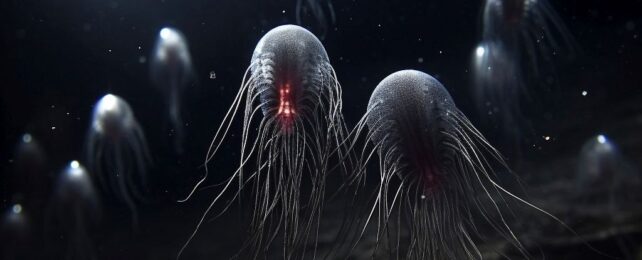 Artistic interpretation of organisms in the Protosterol Biota. (Orchestrated in MidJourney by TA 2023)
Artistic interpretation of organisms in the Protosterol Biota. (Orchestrated in MidJourney by TA 2023)Traces of molecules found in ancient rocks are revealing a wild ecosystem of early life that hunted and thrived in the world's oceans for nearly a billion years.
Biomarker signatures found in rocks dated to 1.64 billion years ago were left by an entire range of previously unknown organisms that dominated life on Earth, in a low-oxygen world an eon before the emergence of plants, animals, and fungi.
These organisms were unlike anything alive today; their discoverers, led by paleobiogeochemists Jochen Brocks and Benjamin Nettersheim of the Australian National University in Australia, have collectively named them the protosterol biota.
They could be the world's earliest predators, feasting on microbes abundant in the oceans at that time; and they also appear to be the ancestors of all eukaryotic life on Earth. That's all the plants, animals and fungi that are around now – including us.
"Molecular remains of the protosterol biota detected in 1.6-billion-year-old rocks appear to be the oldest remnants of our own lineage – they lived even before the Last Eukaryotic Common Ancestor (1.2 billion years ago)," says Nettersheim, who is now at the University of Bremen in Germany.
"These ancient creatures were abundant in marine ecosystems across the world and probably shaped ecosystems for much of Earth's history."
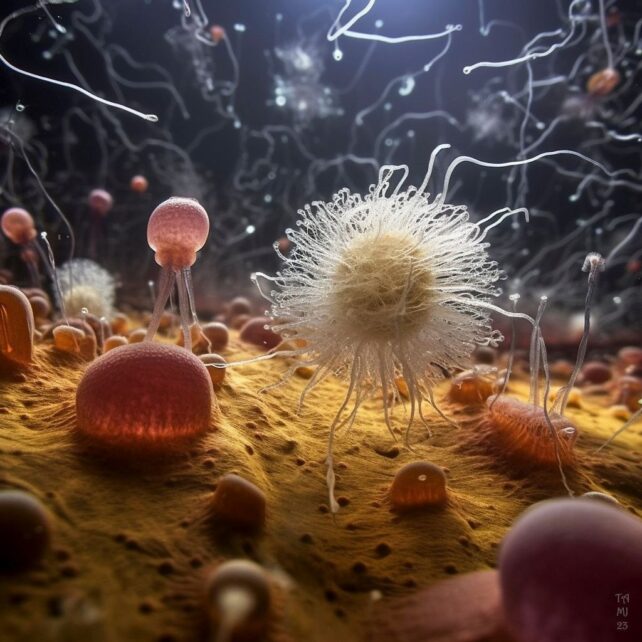
Because eukaryotic life – organisms whose cells contain a nucleus – is so dominant today, scientists think that it must have emerged more than a billion years ago.
Paleobiologists have been on the lookout for these early eukaryotes for a long time, but identification of ancient organisms is challenging at best. Since it's been more than a billion years since they lived, any traces they may have left behind are likely to be extremely degraded, and difficult to confidently diagnose.
The discovery was made analyzing rocks from waterways around the world, the oldest of which were from the Barney Creek Formation in Australia, dating to 1.64 billion years ago.
They were specifically looking for steroids, a biomarker of early eukaryotes first predicted by Nobel laureate biochemist Konrad Bloch in 1994, as nearly all eukaryotes can synthesize steroids, such as cholesterol.
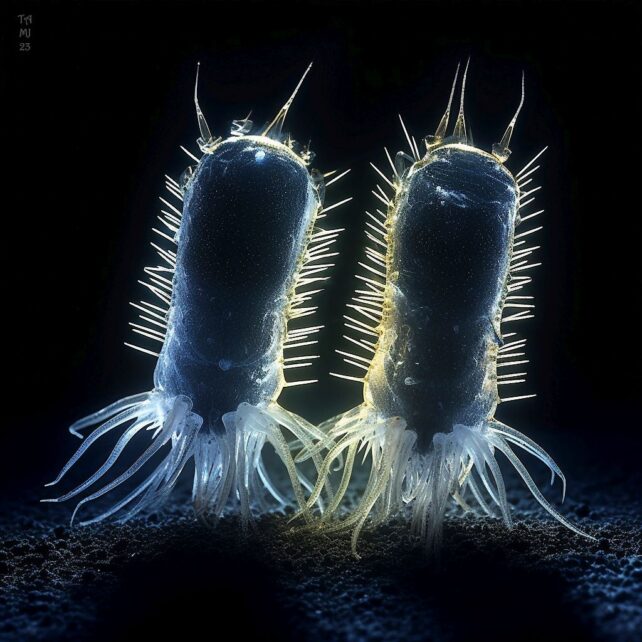
"We employed a combination of techniques to first convert various modern steroids to their fossilized equivalent; otherwise, we wouldn't have even known what to look for," Brocks explains.
He adds, "Scientists had overlooked these molecules for decades because they do not conform to typical molecular search images. Once we knew our target, we discovered that dozens of other rocks, taken from billion-year-old waterways across the world, were oozing with similar fossil molecules."
The discovery shows that these eukaryote biomarkers had been hiding in plain sight all along, although what the creatures that produced them were like remains unknown, since fossils of the creatures themselves have not been found.
However, the researchers believe that the organisms of the protosterol biota were larger and more complex than bacteria, and thrived on them as the next chain up in the food web. "We believe they may have been the first predators on Earth, hunting and devouring bacteria," Brocks says.
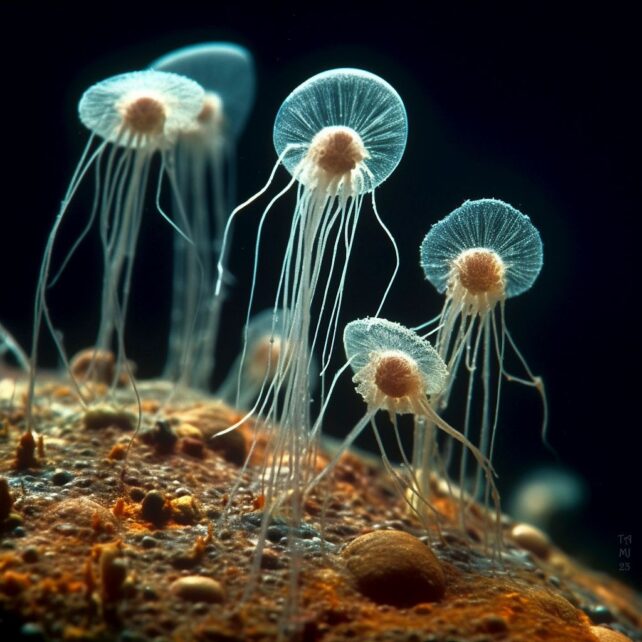
Interestingly, the traces left behind by these creatures stopped appearing in the fossil record around 800 million years ago. After this point, algae and fungi begin to appear; the first animals are thought to have emerged about 700 or 600 million years ago.
The decline of the protosterol biota and the emergence of other organisms is known as the Tonian Transformation, and it's one of the most profound alterations Earth's ecology has undergone, allowing for the rise of modern eukaryotes.
The discovery of sterols very similar to those our bodies produce today, in a very different set of organisms, allows us to trace our history back to a time much farther than ever before.
"The highlight of this finding is not just the extension of the current molecular record of eukaryotes," says paleobiogeochemist Christian Hallmann of the German Research Center for Geosciences in Germany.
"Given that the last common ancestor of all modern eukaryotes, including us humans, was likely capable of producing 'regular' modern sterols, chances are high that the eukaryotes responsible for these rare signatures belonged to the stem of the phylogenetic tree."
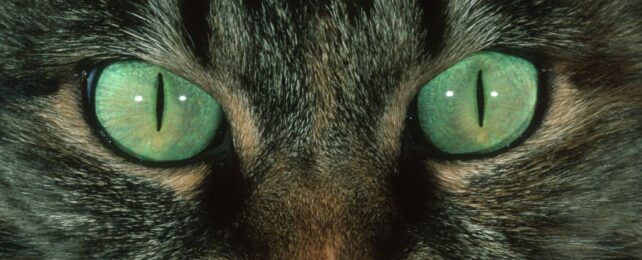 |
| Felines are the definitive host of famous parasite Toxoplasma gondii, thought to influence the behavior of its hosts. (Martin Harvey/The Image Bank/Getty) |
Life is not always straightforward about the business of living.
A food web, for instance, consists of chains upon chains of organisms stealing other organisms' energy-processing abilities.
We can't process sunlight into the sugars we need for energy; we wait for plants to do it, and eat them. Carnivores can't properly digest plants; they wait for other animals to eat plants, then eat those animals.
In other words, most of us piggyback off other organisms in some way – but parasites take the notion to its ultimate conclusion. Why go about the hard work of living when you can get some other creature to do it for you? Or, even better, make them do it for you.
This is the wild west of parasitology: when a parasite doesn't just hitch a ride, but hijacks the body of their host in some way, driving it to behaviors that benefit the parasite – often to their own great, even fatal, detriment.
"In the scientific literature, the name for that is adaptive host manipulation hypothesis," parasitologist Alex Maier of the Australian National University told ScienceAlert.
You may have heard of this before. One of the most well-known examples is Toxoplasma gondii, which causes a disease called toxoplasmosis.
Studies have found that animals infected with T. gondii exhibit behavioral changes, taking more risks, and behaving in ways that may make them more likely to encounter cats – the only host in which the parasite can reproduce.
Whether or not T. gondii does actually manipulate hosts is still under investigation, but T. gondii is just one parasite. There are many parasites out there tweaking their hosts in different ways… and the fascinating thing is that often we have no idea how they actually do it.
Let's get physical
Parasites live a very complicated and circuitous life, but it seems to be incredibly effective. While some parasites stick to one host for their whole life cycle, others require multiple hosts to complete their biological journeys.
Here's how the more complex life cycles tend to work. A parasite reproduces and lays eggs in what is known as the definitive host. Those eggs are shed into the environment, usually in feces; the eggs or larvae are then taken up by the first intermediate host.
There, the parasite continues to develop, and from here can either continue to grow to maturity, or make its way to a second intermediate host to complete its growth.
Once it is fully grown and ready to reproduce, it needs to make its way back to the definitive host – often a specific type of animal, like T. gondii and cats.
Ribeiroia ondatrae, the frog-mutating flatworm, is a flatworm that, like its name indicates, mutates frogs. Specifically, it seems to target the frogs' hind legs. Frogs infected with this parasite grow additional, useless limbs – sometimes lots of them.
Another flatworm, called Leucochloridium paradoxum (the green-banded broodsac), enters the eyestalks of snails, where it swells and pulsates, creating an eye-catching display of movement and color.
In both of these cases, the ultimate target of the parasites is not the frogs, or the snails. Both R. ondatrae and L. paradoxum live and grow in the bodies of their intermediate hosts, but they can only reproduce in the bodies of birds (or also mammals for R. ondatrae).
"So that's the swelling of the eyestalks and this pulsating behavior in the eyestalks. Similarly, they move out into the open so that the birds come in, and then they can pick off those eye stalks."
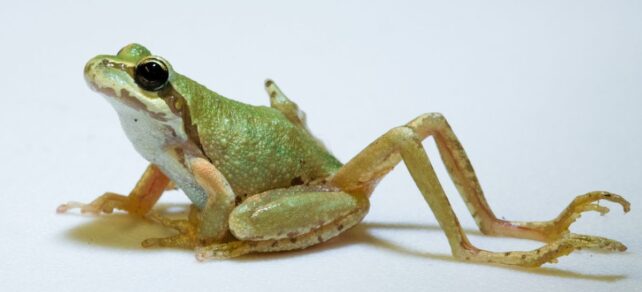 |
| Pacific chorus frog (Pseudacris regilla) infected with R. ondatrae. (Goodman & Johnson, PLOS ONE, 2011) |
Once the fluke has reproduced, the eggs are shed with the feces of the host, and subsequently eaten by snails, where they hatch and develop. At this point, they make their exit through the snails' slime, which contains a sugary substance that is very delicious to ants.
Inside the ant, the parasite develops to maturity… and from there, the ant is eaten by cattle and sheep, where it can begin the life cycle all over again.
"The logical flaw is the cow is vegetarian. Why should they eat ants?" Maier says.
"Actually, infected ants climb up grass in the evenings. During the day they show normal behavior. In the evenings when the temperature drops, normally the ants go back into their nest. But those infected ones climb up the grass. And then when the temperature drops further, they spasm in their mandibles, and they actually lock themself to that grass.
"So they spent the night on that grass; in the morning the cow comes along, eats the grass, and picks up those infected ants."
Somehow, the parasite hijacks the ant and drives it to fatal behavior to get back to the fluke sex party happening in cows.
We do know, a little, about how D. dendriticum might be pulling this off. A few years ago, a team of researchers conducted CT scans of parasitized ants, and found that, while the majority of the parasites were clustered in the abdomen, there was almost always one lone parasite situated right next to the ant's brain.
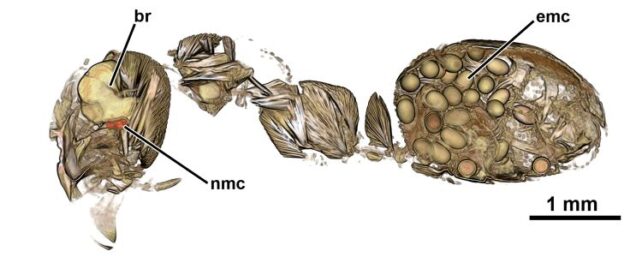 |
| False-color CT scan of an ant, showing encysted parasites in the abdomen (emc) and one non-encysted parasite in the brain (nmc). (Martin-Vega et al., Sci. Rep., 2018) |
In many cases, though, we don't know the actual strings being pulled, especially for human parasites. The reason for this is that we're usually relying on behavioral data, and behavior is a complex thing with countless possible drivers, including personality. And there can be bias in the way we select behavioral data for inclusion in research.
A birth-cohort study published in 2016, for example, found little evidence to support the notion that Toxoplasma gondii leads to increased risk of psychiatric disorders or increased impulsivity in humans, as had previously been asserted.
In fact, it's not definitively clear that T. gondii manipulates rodents, either. A 2013 study found the evidence unconvincing. It can be extremely difficult to conclusively link such changes to parasite manipulation.
Perhaps the host is simply behaving differently because they feel ill… you know, because they have a parasitic infection.
The case for rabies is more compelling. Behavioral symptoms include hyperactivity, insomnia, and an extreme fear of water and fresh air, which scientists have linked to a toxin-like neuroinhibitor released by the virus Rabies lyssavirus.
By the time symptoms appear in rabies, it's too late to do anything about it; such cases are almost always fatal. And we have no way to diagnose rabies prior to symptom onset.
Although relatively few parasites are known to alter human behavior, though, adaptive host manipulation is a field that warrants further investigation. These tiny hitch-hikers actually have a huge impact on the larger world.
Driving evolution
The battle between parasite and host is a sort of evolutionary arms race. The parasite wants to maximize its chances of arriving at its definitive host; the host wants to minimize its chances of parasite sickness.
So parasites will develop adaptations that help it infect its hosts, and the hosts increase resistance and tolerance to the parasites in response.
This can have some pretty interesting consequences. One psychologist even theoretically explored the notion that the evolution of the human brain could have, at least in part, been driven by parasites.
While purely speculative, the idea has some interesting implications, such as mimicking a parasite attack to stimulate the brain's defense mechanisms.
It's not that strange an idea. Recent research has shown promise in treating irritable bowel conditions such as coeliac disease and Crohn's disease with parasitic worms that live in the gut, known as helminth therapy.
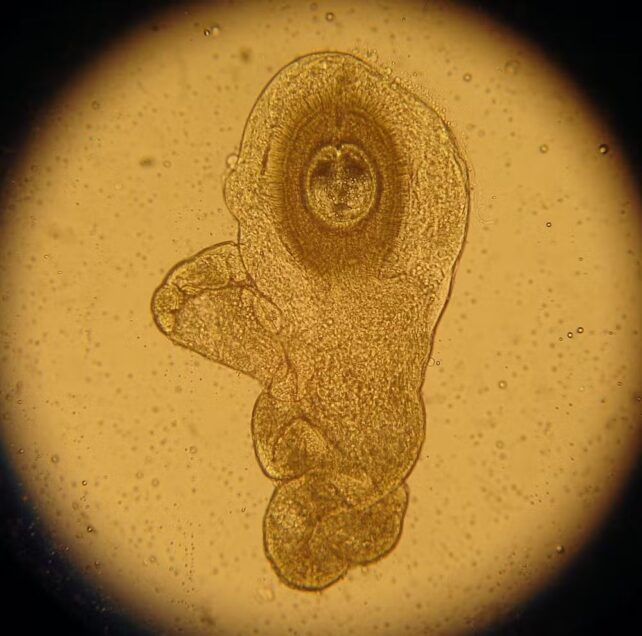 |
| The rat tapeworm (Hymenolepis diminuta), commonly used for self-treatment of inflammatory disorders. (William Parker, CC BY-NC SA) |
These are autoimmune conditions, and the response to parasite infection suggests one potential reason for it, Maier says.
"In the last 50 years, some parts of the human race have grown up in a hygienic environment – that's the hygiene hypothesis," he explains.
"And the part of our immune system that normally used to deal with those wormy parasites is now sitting idle. It has nothing to do. And in some individuals, it starts attacking their own tissue."
Parasitism forces both hosts and parasites to diversify, to enter new ecological niches, to adapt. Populations of animals with parasites have greater genetic diversity, because that limits parasite success.
If we can link parasite behavior to our own evolutionary adaptations, that could have some implications for how we treat, or even prevent, some forms of disease.
Beyond that, however, parasites that are able to manipulate their hosts give us clues to understanding their biology. Altering a neurotransmitter, for example, as rabies does, helps us learn how that neurotransmitter works.
We have a tendency to think of parasites with disgust and revulsion, but there's a lot more going on with these mooching organisms than pulsating eyestalks, no matter how vivid and eye-catching they are.
Maybe the idea of adaptive host manipulation opens up all sorts of philosophical questions about the malleability of our own identities, but perhaps our tiny passengers are also driving us all onward and upward to greater things.





No comments:
Post a Comment